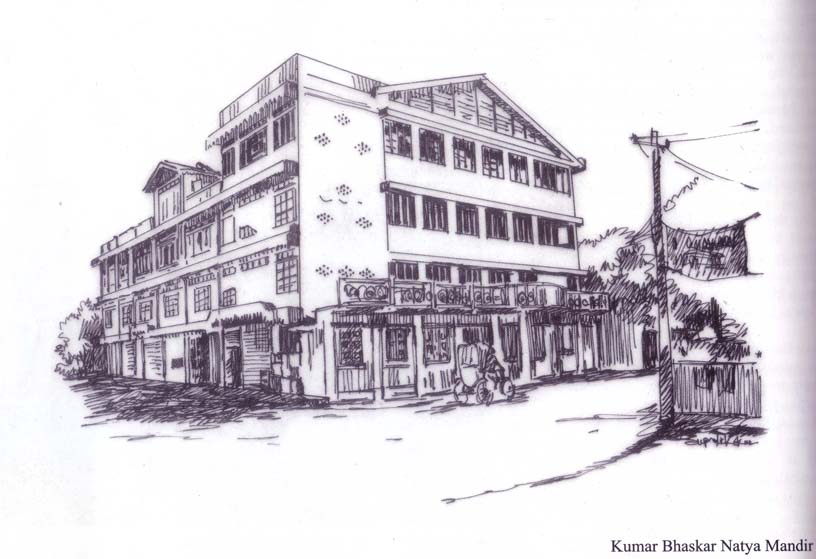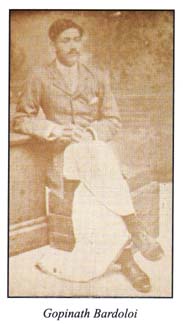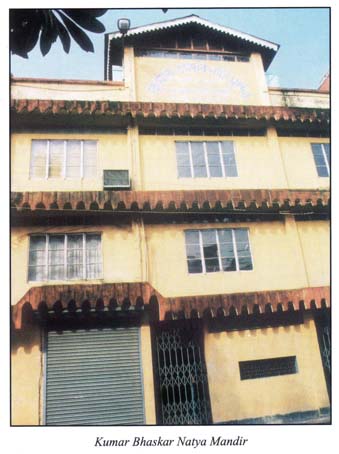| SETTING THE STAGE |
 |
The Arya Natya Mandir was established about a year after the town’s first theatre hall near Lamb Road was razed to the ground in the 1897 earthquake. The management of Arya Natya Mandir largely comprised of prominent Bengali citizens of the town, but both Assamese and Bengali cultural programs were held regularly on its stage. In 1912, however, during a drama festival organized in connection with the coronation of George V, an unfortunate incident occurred, and a few gentlemen decided to established a theatre hall for staging “original Assamese drama”.
|
Bholanath Das, Jogendranath Barua, Chidanada Chowdhury, Radhanath Phukan, Saatyendranath Bora, Durgeswar Sarma, Chidanada Sarma and a few other culturally-inclined citizens managed to arrange for a plot of land at the site of the Doloi Ugratara Temple in Uzanbazar from Harinath Sarma, with permission of the lessee Nabin Chandra Bordoloi. Fundraising started with Chidananda Chowdhury donating Rs 600. Tin for construction of the roof of the hall was procured at a cost of Rs 400. Sambhunath Bora and Bholanath Das even worked physically for the construction of the hall that was completed in 1915. The hall was initially named Gauhati Public Hall. The first backdrop of its stage depicted a scene from Ramachandra’s Setubandhan, drawn by Shyama Das who came all the way from Dacca. The same year the Kamrup Natya Samiti was formed - with Gopinath Bardoloi as secretary and Raghunath Choudhury as stage manager - and it assumed full responsibility of the hall and the stage. Some of the earliest dramas staged at this hall were Meghnad Badh, Chandragupta Maurya, Chandravalli and Partha Parajay. Those who acted on its stage in its early years included Gopinath Bardoloi, Raghunath Chowdhury, Manik Chowdhury, Triguna Prasad Barua, Kumudeshwar Goswami and ‘dancer’ Charu Bordoloi. Gopinath Bardoloi’s acting talents were amply demonstrated in his roles as Alexander in Chandragupta, Janardhan in Chandrabali and Betal in Partha Parajay. |
|
In 1924, the hall was renovated with donation from Mahendranath Barua, a planter from Golaghat, and thereafter named the Kumar Bhaskar Natya Mandir (KBNM) after Kumar Bhaskar Barman, former ruler of Kamrupa. During this period, Jyptiprashad Agarwalla, Mahendranath Dekaphukan, Umesh Chandra Choudhury and Dr Bhubaneswar Barua got involved in its activities. Jyotiprasad established his Chitralekha Natya Sangha and used KBNM quite often for staging programs.
|
|
With the passage of time the KBNM began to require a facelift. In 1939, a sum of Rs 4,445 and six annas was collected from public donation to renovate the hall. In the 1940s the Guwahati Sandhya Sanmelani was established in its premises, adding a new dimension to the KBNM. Regular drama and cultural programs began to be held and the hall got a new lease of life. Since it had been decided that only original Assamese dramas would be staged in the hall a group of new dramatists came forward. Atul Chandra Hazarika, Prabin Chandra Phukan, Lakhyadhar Chowdhury and actors like Satya Prasad Baru and Subho Barua were the torch bearers of the neo-Assamese drama movement centering round KBNM. |
Prabin Chandra Phukan’s Maniram Dewan, Lachit Barphukan and Kal Parinaya Nipirita and Lakhyadhar Chowdhury’s Rakhsya Kumar, Ram Rajya and Alibaba were some of the new crop. On August 5, 1950, male and female artistes acted together on the KBNM stag for the first time in Prabin Phukan’s Pratibad. The female cast included Baruna Mukherjee, Reba Das, Minu Patra, Kausalya Das, Reba and Mina Dutta.
KBNM remained closed for an unusually long time on two occasions - first in 1929-30 when the hall was converted into a Congress godown for storing khadi and spun and then in June 1942 when the office of the Air Raid Protection (ARP) department was shifted here.
|
After Independence the hall got a new lease of life with important personalities like Lakhyadhar Choudhury, Satya Prasad Barooah, Ramesh Chowdhury, Pulin Das, Dilip Hazarika, Kshirod Bishya, Sonadhar Das, Ishan Baruah and others joining in. The lifeline of the Kumar Bhaskar Natya Mandir was however its dedicated off-stage workers. Lalit Chowdhury spent years as its secretary. Ram Gosain (Goswami) remained so busy selling tickets that he never got to watch anything but the climax of a drama. Phatick Bordoloi popularly known as Phatick Master was another hall worker who acted in several drama but never once got to speak a word on stage. For about 25 years since 1975, the hall’s dilapidated condition did not favour production of modern drama. In the year 2000, the dedicated efforts by Ishan Barua, Saila Barua and others bore fruit and the Natya Mandir was thoroughly renovated. In addition to anew stage, better acoustics, side paneling and facilities for screening cinema, the hall now also has a cultural complex and an art gallery that has been dedicated to the nation. History was created on May 10, 2000 when a few weeks before his death, the thespian of Assamese theatre, Lakhyadhar Chowdhury, took to this stage again to perform in Thikona, a drama he had written and acted in on the KBNM stage 60 years earlier. |
|

%20in%20the%20play,%20Thikona%20staged%20at%20KBNM%20in%202000.jpg)
